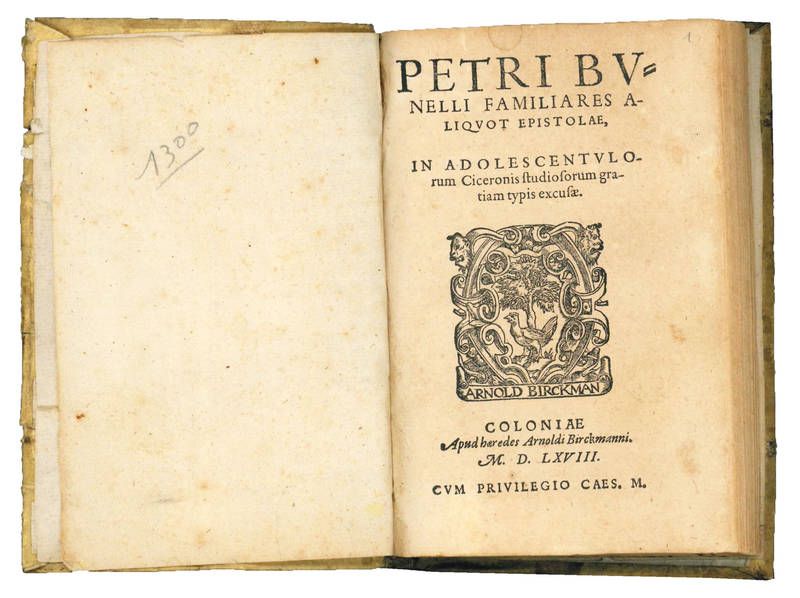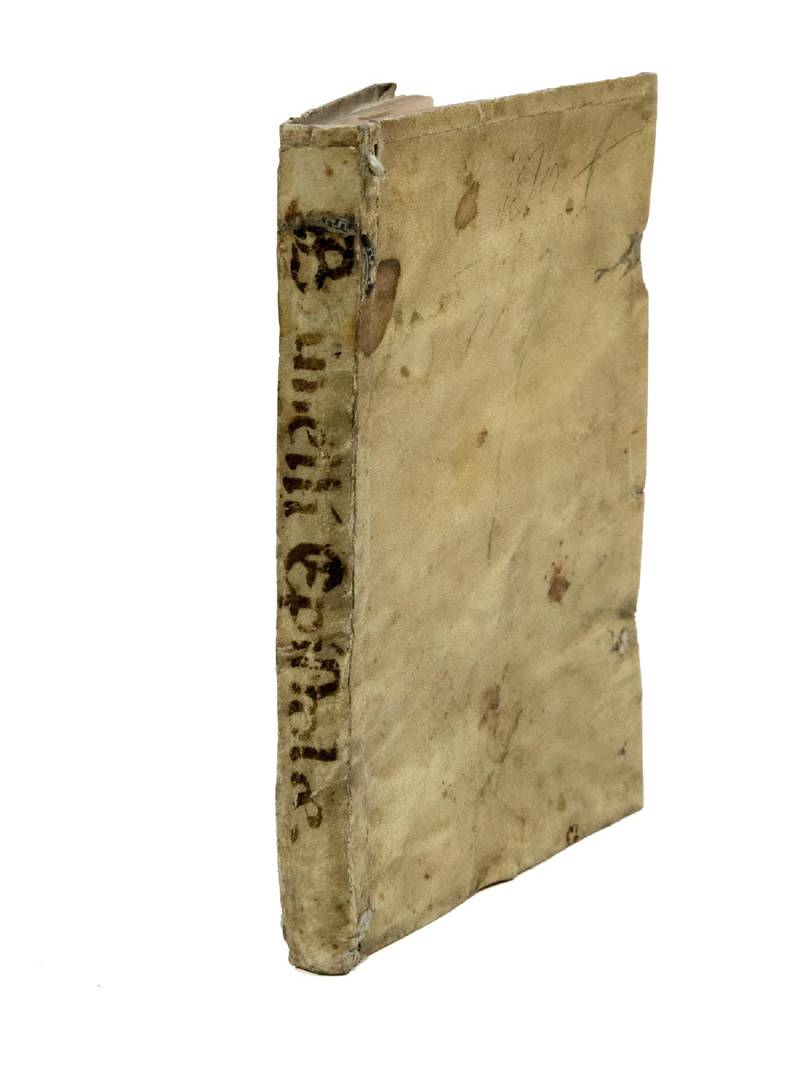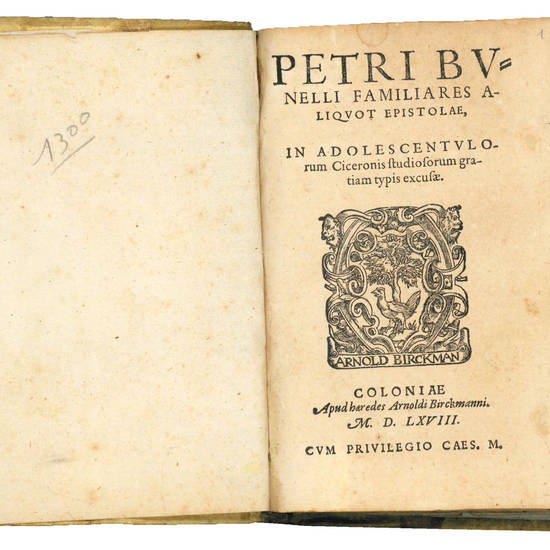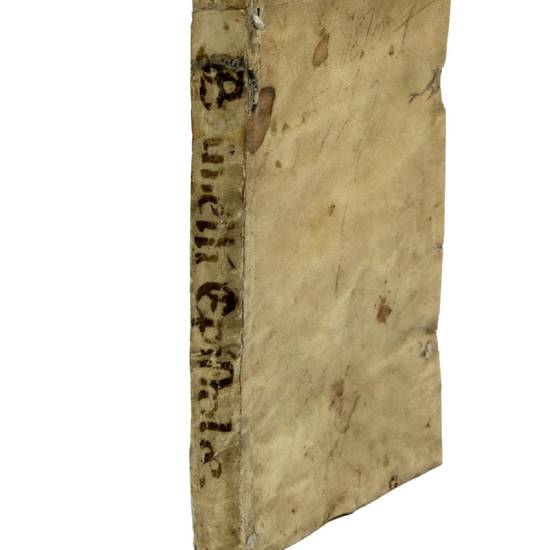8vo. (72) leaves. A-I8. With the printer's device on the title-page. Contemporary limp vellum.
Index Aureliensis, 127.672; VD 16, B-9783.
SECOND EDITION. The first appeared in Paris in 1551. The editor is Charles Estienne who signs the dedication to the “adolescentibus bonarum litterarum studiosis”. It follows a letter of Paolo Manuzio addressed to Guy du Faur sieur de Pibrac (Venice, November 28, n.y.).
The letters of Bunel were reprinted several times. Henri Estienne published them in 1581 together with those of Paolo Manuzio and some other French and Italian humanists. The 1687 edition printed in Toulouse demonstrates the high reputation Bunel still had after more than a century.
“Humaniste reputé en son temps, Pierre Bunel est pour Montaigne l'homme qui offrit autrefois à son père le Liber Creaturarum de Raimond de Sebond […] Tout porte à croire que c'est de Toulouse, entre 1541 et 1546, qu'il se rend, pour un court séjour, au château de Montaigne, où Pierre Eyquem, futur maire de Bordeaux […] aime à s'entourer de la compagnie des lettrés. C'est pour marquer sa gratitude envers l'acceuil à lui reservé, ainsi qu'à ses amis, que Bunel fait present à Eyquem, ‘au déloger', d'un ouvrage dû à un écrivain toulousain à qui les circonstances semblent promettre une renommée autre que purement locale” (M. Habert, Pierre Bunel, in: “Dictionnaire de Michel de Montaigne”, Ph. Desan, ed., Paris, 2004, p. 151).
Baïf, Lazare de. Padova, October 27, n.y. (l. A5v)
Perrot, Milles. Venezia, November 23, 1530 (l. A7r)
Caussade, Jean (l. B1r)
Perrot, Milles. Venezia, November 30, 1530 (l. B1v)
Villeneuve, Simon de (l. B3r)
Corner, [Andrea]. Venezia, October 31, 1531 (l. B3r)
Magetano, Giuseppe. Venezia, November 13, 1531 (l. B4v)
Perrot, Milles. Venezia, September 30, 1531 (l. B6v)
Sadoleto, Jacopo (l. C2r)
Perrot, Milles. Venezia (l. C3v)
Ramberti, Benedetto. Venezia (l. C4r)
Perrot, Milles. March 2, n.y. (l. C4v)
id. Venezia (l. C5r)
id. Venezia, January 2, n.y. (l. C6r)
Du Faur, Pierre. Venezia (l. C6v)
Perrot, Milles (l. C7v)
id. November 27, n.y. (l. C8v)
id. Venezia, December 31, n.y. (l. D1r)
De Paulo, Antoine. Venezia (l. D2v)
Perrot, Milles. December 13, n.y. (l. D3v)
id. Venezia, January 4, 1531 (l. D4r)
Chandon, Renaud (l. D5v)
Perrot, Milles. January 29, 1531 (l. D7v)
id. Venezia (l. D8v)
id. Venezia, July 21, n.y. (l. E1v)
id. November 6, n.y. (l. E3v)
id. Venezia, February 23, n.y. (l. E4v)
Phorcrisius, Claude. Roma (l. E6r)
Perrot, Milles. Venezia, June 12, 1532 (l. E7r)
Manuzio, Paolo (l. F1r)
Perrot, Milles (l. F1v)
Selve, Jean Francisque de (l. F2v)
Perrot, Milles. October 14, 1531 (l. F3r)
Cognetius, Georges (l. F5r)
Chandon, Renaud (l. F5v)
Perrot, Milles (l. F6r)
Ranconnet, Aymar de (l. F6r)
Montclar, Vicomte de. January 13, n.y. (l. F7r)
[Selve, George de]. Lavaur, March 15, n.y. (l. F8r)
Selve, Jean Francisque de (l. G2r)
Du Chastel, Pierre (l. G3v)
Breslay, Guy (l. G4v)
Du Faur, Jacques (l. G5r)
Du Faur, Pierre and Du Faur, Jacques. Toulouse (l. G6r)
Selve, Jean Francisque de (l. G6v)
Baïf, Lazare de (l. G7r)
Ranconnet, Aymar de (l. G7v)
Selve, Odet de. Toulouse, December 31, 1541 (l. G8v)
Danès, Pierre. Toulouse, July 19, 1541 (l. H1v)
Selve, Odet de. Toulouse, April 25, 1531 [recte 1541] (l. H5r)
Du Faur, Jacques (l. H5v)
Selve, Odet de. Toulouse, August 13, 1541 (l. H6v)
Bertrandi, Jean (l. H7r)
Du Ferrier, Arnaud. Toulouse (l. H8r)
Olivier, François (l. I1v)
Du Faur, Jacques (l. I3v)
Selve, Odet de. Venezia, January 19, 1534 (l. I4v)
Pierre Bunel, a native of Toulouse, studied in Paris at the Collège Coqueret, and afterwards came back to his hometown. In 1529 he went into exile in Italy, for religious reasons, and remained there until 1537. He then stayed in Padua, where he met many students of the University of Toulouse, who came there to complete their studies, e.g. Milles Perrot, Michel de L'Hospital, Aymar de Ranconnet, Renaud Chandon, and Georges Cognet. Afterwards he moved to Venice and entered there the service of the French ambassador, Lazare de Baïf. During his stay in Venice he studied Greek and Hebrew, but periodically visited in Padua his fellow exiles Jacques de Bernuy, Arnaud du Ferrier, Jacques du Faur, Paul and Jean Daffis, and Antoine de Paulo, who later all became members of the parliament of Toulouse or Paris. In spring 1532 he visited for the first time Rome, where he was guest of his friend Jacques de Bernuy, scion of a wealthy family of Toulouse. He returned to Rome five years later, accompanying Georges de Selve, the new French ambassador to Venice (one of the two ambassadors portrayed in the famous painting by Hans Holbein the Younger).
When in 1538 Georges de Selve, bishop of Lavaur, came back to his episcopal seat Bunel followed him. Meanwhile Pierre du Faur, Jacques' brother and member of the Paris parliament, had successfully intervened with the king to cancel the prosecution for sedition that was pronounced against Bunel nine years earlier. In 1541, after de Selve's death, Bunel returned to Toulouse and entered the service of Pierre du Faur, becoming the tutor of his sons, in particular of Guy. Bunel died in Turin in 1547 while traveling in Italy with his pupils.
Initially attracted by the Reformation, Bunel ended his days in the bosom of the Catholic Church, that he wanted to change from within, incurring Calvin's and Théodore de Bèze's enmity. At the end of his life he had become a moral and intellectual authority. Praised by Montaigne, he was compared to Socrates and considered a new Cicero for the purity of his Latin (cf. M. Magnien, Les milieux humanistes toulousains à travers la correspondance de Pierre Bunel (1500-1547), in: “L'humanisme à Toulouse (1480–1596), Actes du colloque international de Toulouse, mai 2004”, Paris, 2006, pp. 247-269).
[9062]





